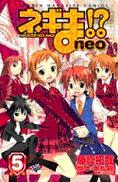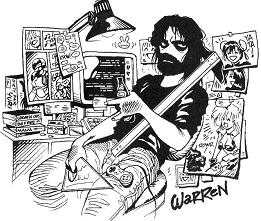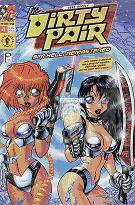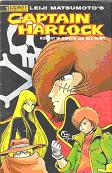|
March 2009
Last time I looked at the very interesting phenomenon of adapting American Superhero original material to the manga format. While a subset of its own in manga it is still by and large a rarity in Japanese manga. However, the reverse is not true when it comes to American comic books.
When one looks at the graphic novel marketplace in U.S. stores it is more likely to find manga dwarf traditional graphic novels in terms of bookshelf space, but in addition to that the tendency of American made "manga", which is reference to by many titles, is quite a large sub-section of this great manga glut. In looking at this what are the elements of manga that apply to titles that don't come from Japan? Are these manga? And what forms do they take? Well in this month's column I will look at the flip side of what I analyzed last month, when original Japanese concepts are taken by Americans and done in comic book format, both as adaptations and as original stories.
The rarity of Japanese concepts for manga, or anime, being taken and done by others who are not the original creators is extremely rare. There are examples though, such as the new Negima!? Neo which is based off the original but not done by the original creator, or the Yu-Gi-Oh GX manga.
However, if you consider percentage wise that maybe 5% of all manga done
|
is based off a concept not created by the person working on it, such as
Negima!? Neo or the manga based off the Vampire Hunter D novels, then probably somewhere around 0.03 % is the amount of concept that have been done by foreign creators based off Japanese original concepts that are manga or novel based. (I'm excluding things like Transformers and Power Rangers that are not manga based ideas, however something like Vampire Hunter D that is based off a series of novels and has both an anime and manga I would include.) Less then a handful of original stories have ever been done based off Japanese concepts by foreigners, and none that I know of were based off manga specifically, but instead based off anime or Japanese novels. All of these concepts though were done as comic books, printed at the standard comic book size, and can be counted on one hand, and over half of them have been done by or involved just one creator: Adam Warren.
| |  |
 | |
Adam Warren began in the late eighties serving as the artist for a series of graphic novels creating new stories and ideas for the Dirty Pair. A series of novels in Japan, the Dirty Pair has also had several anime movies and series done about this duo of female agents for a interplanetary peace keeping force, the 3WA, who finds that this duo, actually codenamed "The Lovely Angels" cannot seem to do a job without causing mass destruction, thus the nickname "Dirty Pair". (Indeed if one looks at the title "Dirty Pair: Affair On Nolandia" one might think it was pornographic! Which the series is definitely not . . . though their outfits
|
| don't leave much to the imagination . . . ) Adam Warren went on to create many mini series based on this duo, though the mid nineties, and did an additional mini-series based on the popular 80's OVA Bubblegum Crisis as well. In looking at comics based off Japanese prosperities with original content, Warren alone is responsible for 40 to 50% of the material generated. But is it manga? Well size wise, considering it was published before the mass move to tokuban-size, it isn't done that way, but that obviously isn't the main consideration. Warren, a huge lover of anime and manga, adopted most of the main conventions of manga style, including
speed lines, use of absent space, exaggerated motion and expression, giant eyes, and visual sound effects, that manga-ka use. In addition, he was using
| |  |
Japanese original concepts, with a lot of wacky American sci-fi ideas thrown in, making it more "authentic" perhaps then any "manga" out today claiming to be "Original English Language Manga" (a concept we'll talk about next time, especially considering that Adam Warren is known to some American Super-Hero fans for his fun Gen 13 run, Titans Rock, Paper, Scissors, Iron Man Hypervelocity, and more . . . an example of someone who brought a lot of the manga sensibility to American comics). So here we have an example of "American" manga as it were.
However, this represents such as small sampling, as Warren's works, along with three mini-series that Pioneer, a major anime distributor in the 90's, released in the 90's based off their very popular Tenchi-Muyo and El-Hazard, and lesser known Phantom Quest Corp., anime series that were done by American creators with brand new original storylines, and the Eternity Captain Harlock comics, all over examples of others doing "American manga" are all adaptations.
 | |
In that arena there have been numerous entries with Eternity (through the now defunct Malibu Comics) doing a great amount of them along with CPM. (Yes, there are also the Robotech comics as well, but I will tackle the elements of manga associated with them and shows like Voltron at a later date.) Another name to add to taking Japanese concepts and adapting them to "American manga" is Tim Eldred who wrote and drew projects for CPM and Malibu/Eternity such as Captain Harlock, Project A-Ko, M.D. Geist, and Votoms. Interestingly, Harlock's trademark rights for original material was a bit of a thorny issue . . . since a non-Leiji Matsumoto version of Harlock was not
|
desired . . . but nevertheless created. (Both serving as artist and writer, Eldred will be a name we'll see return when discussing "Original English Language Manga" next month.) This influx came primarily from anime companies gaining the intellectual rights to anime properties and seeing "adapting" them into "comic book format" as a way to bring in additional cash. Also this approach falls in line much more with how American comics are done, with creators working off anime properties that were corporate owned, not owned by individuals . . . sound familiar? (I'm not just staring at DC and Marvel . . . just mostly.)
However, the tendency for original material created by creators other then the original Japanese ones is extremely rare, and even rarer when it comes to foreigners doing so. So are they manga? Do they have elements of manga in them? I'd say yes, but some would disagree since the hard line definition that many American fans have adopted, that manga is only comic material created in Japan, makes "American" manga by that definition . . . not manga. Yet, if you look at the elements of manga you can find them . . . even from the American part of the world.
|



